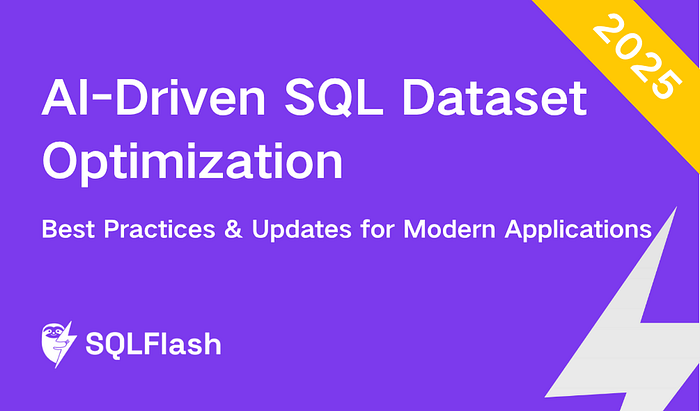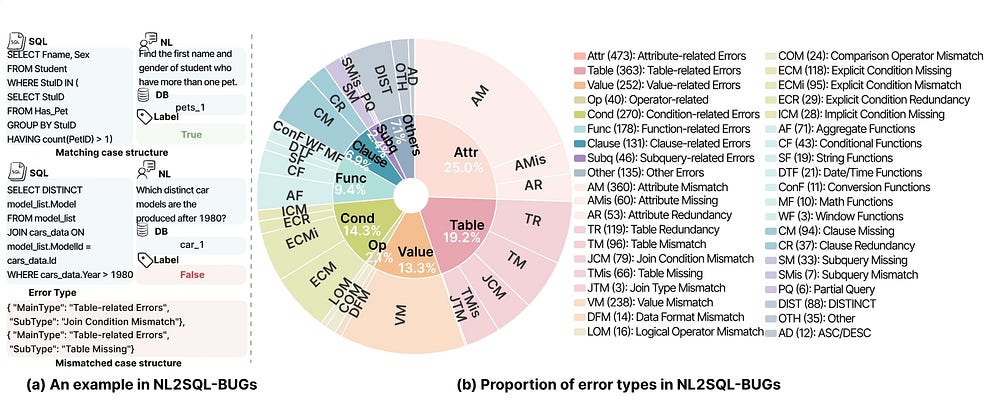AI-Driven SQL Dataset Optimization: Best Practices & Updates for Modern Applications
 SQLFlash
SQLFlash
When we conduct AI research in the field of SQL, we find that the improvement of application capabilities in the SQL field largely depends on high-quality datasets. We need to synthesize data based on this to generate training sets and evaluation sets for specific problems. To help more developers quickly access resources, we have sorted out a list of publicly available Text2SQL datasets in recent years and share them with you here.
We have organized the papers and dataset addresses of the datasets in chronological order, including representative Text2SQL datasets in recent years. Among them, representatives of the evaluation set: Spider, BIRD-SQL, we have also associated the leaderboard in our list.
Next, I will focus on introducing the latest dataset in 2025, and will continue to collect and bring the latest information to everyone.
Introduction to New Datasets
NL2SQL-Bugs
NL2SQL-BUGs is the first benchmark dataset focusing on detecting semantic errors in NL2SQL translation, aiming to solve the problem that the SQL queries generated by existing models have semantic errors that are not recognized by the system. This dataset constructs a two-level classification system (9 categories and 31 subcategories) through expert annotation, containing 2,018 instances (with error annotations). Experiments found that the current large model’s average detection accuracy is only 75.16%, and successfully identified 122 existing annotation errors in the BIRD and Spider benchmarks. This achievement provides an important validation set for error detection and correction of NL2SQL systems.

OmniSQL
SynSQL-2.5M is the dataset released in the OmniSQL paper, which the author believes is currently the largest cross-domain text-to-SQL synthetic dataset. It is built using pure synthetic data technology, containing 2.5 million high-quality samples, covering 16,583 databases and a large number of diverse SQL syntax structures. This dataset is generated based on open-source large models, providing high-quality data that can be directly used for training, and is open under the Apache 2.0 license. The OmniSQL series of large models (7B/14B/32B) are also released. Developers can also use this dataset to train their own models.

TINYSQL
TinySQL is a progressive text-to-SQL dataset aimed at solving the problem that existing SQL datasets are too complex and not suitable for mechanism interpretability research. By controlling the complexity of SQL commands and language variants, it provides query tasks from basic to advanced levels, supporting model behavior analysis. This dataset helps researchers understand how Transformers learn and generate SQL queries, and evaluate the reliability of interpretability methods. Application scenarios include model mechanism analysis, interpretability technology verification, and improvement of synthetic dataset design.

Datasets Lists
Latest Datasets (2025)
TINYSQL | [Paper] [Dateset] | 2025/03, TinySQL is a structured text-to-SQL dataset designed to support interpretability research by bridging toy examples and real-world tasks with controllable complexity.
NL2SQL-Bugs | [Paper] [Dateset] | 2025/03, NL2SQL-BUGs is the benchmark dedicated to detecting and categorizing semantic errors in Natural Language to SQL (NL2SQL) translation. While state-of-the-art NL2SQL models have made significant progress in translating natural language queries to SQL, they still frequently generate semantically incorrect queries that may execute successfully but produce incorrect results. This benchmark aims to support research in semantic error detection, which is a prerequisite for any subsequent error correction.
OmniSQL | [Paper] [Dateset] | 2025/03, As of March 2025, SynSQL-2.5M is the largest and most diverse synthetic text-to-SQL dataset to date. It represents a significant milestone in the text-to-SQL community. We encourage researchers, practitioners, and data enthusiasts to explore and build models using this dataset. If you find it useful, please consider giving us a star or citing our work. Your feedback is our greatest motivation to continue advancing.
🗂️ Datasets
WikiSQL | [Paper] [Dataset] | 2017/09, Salesforce proposes a large Text-to-SQL dataset WikiSQL, the data comes from Wikipedia, which belongs to a single domain, contains 80,654 natural language questions, and 77,840 SQL statements. The form of SQL statements is relatively simple, and does not include sorting, grouping, and subqueries and other complex operations.
Spider 1.0 | [Paper] [Dataset] | 2018/09, Yale University proposes the Text-to-SQL dataset Spider with multiple databases, multiple tables, and single-round query. It is also recognized as the most difficult large-scale cross-domain evaluation list in the industry. It contains 10,181 natural language questions and 5,693 SQL statements
SParC | [Paper] [Dataset] | 2019/06, Yale University proposes a large dataset SParC for complex, cross-domain, and context-dependent(multi-turn) semantic parsing and text-to-SQL task…
CSpider |[Paper] [Leaderboard] | 2019/09, Westlake University propposes a large Chinese dataset CSpider for complex and cross-domain semantic parsing and text-to-SQL task, translated from Spider by 2 NLP researchers and 1 computer science student, which consists of 10,181 questions and 5,693 unique complex SQL queries on 200 databases with multiple tables covering 138 different domains.
CoSQL | [Paper] [Leaderboard] | 2019/09, Yale University and Salesforce Research propose a cross-domain database CoSQL, which consists of 30k+ turns plus 10k+ annotated SQL queries, obtained from a Wizard-of-Oz (WOZ) collection of 3k dialogues querying 200 complex DBs spanning 138 domains.
KaggleDBQA |[Paper] [dataset] | 2021/06, KaggleDBQA is a challenging cross-domain and complex evaluation dataset of real Web databases, with domain-specific data types, original formatting, and unrestricted questions.
Spider-Syn | [Paper] [Dateset] | 2021/06, Spider-Syn is a benchmark dataset designed to evaluate and enhance the robustness of Text-to-SQL models against synonym substitutions in natural language questions. Developed by researchers from Queen Mary University of London and collaborators, Spider-Syn is based on the original Spider dataset.
SEDE | [Paper] [Dateset] | 2021/06, SEDE (Stack Exchange Data Explorer) is new dataset for Text-to-SQL tasks with more than 12,000 SQL queries and their natural language description. It’s based on a real usage of users from the Stack Exchange Data Explorer platform, which brings complexities and challenges never seen before in any other semantic parsing dataset like including complex nesting, dates manipulation, numeric and text manipulation, parameters, and most importantly: under-specification and hidden-assumptions.
CHASE | [Paper] [Dateset] | 2021/08, CHASE is a large-scale and pragmatic Chinese dataset for cross-database context-dependent text-to-SQL task (natural language interfaces for relational databases). It is released along with our ACL 2021 paper: CHASE: A Large-Scale and Pragmatic Chinese Dataset for Cross-Database Context-Dependent Text-to-SQL.
Spider-DK | [Paper] [Dateset] | 2021/09, Spider-DK is a benchmark dataset designed to evaluate and enhance the robustness of Text-to-SQL models when handling domain knowledge. Developed by researchers from Queen Mary University of London, Spider-DK builds upon the original Spider dataset.
EHRSQL | [Paper] [Dateset] | 2023/01, EHRSQL is a large-scale, high-quality dataset designed for text-to-SQL question answering on Electronic Health Records from MIMIC-III and eICU. The dataset includes questions collected from 222 hospital staff, such as physicians, nurses, insurance reviewers, and health records teams.
BIRD-SQL | [Paper] [Leaderboard] | 2023/05, the University of Hong Kong and Alibaba propose a large-scale cross-domain dataset BIRD, which contains over 12,751 unique question-SQL pairs, 95 big databases with a total size of 33.4 GB. It also covers more than 37 professional domains, such as blockchain, hockey, healthcare and education, etc.
UNITE | [Paper] [Dateset] | 2023/05, Unified benchmark is composed of 18 publicly available text-to-SQL datasets, containing natural language questions from more than 12 domains, SQL queries from more than 3.9K patterns, and 29K databases. Compared to the widely used Spider benchmark, we introduce ∼120K additional examples and a threefold increase in SQL patterns, such as comparative and boolean questions.
Archer | [Paper] [Leaderboard] | 2024/02, Archer is a challenging bilingual text-to-SQL dataset specific to complex reasoning, including arithmetic, commonsense and hypothetical reasoning. It contains 1,042 English questions and 1,042 Chinese questions, along with 521 unique SQL queries, covering 20 English databases across 20 domains.
BookSQL | [Paper] [Dateset] | 2024/06, BookSQL has 100k Query-SQL pairs which is about 1.25 times the existing largest Text-2-SQL dataset: WikiSQL. In particular, for designing the queries, we consulted financial experts to understand various practical use cases. We also plan to create a leaderboard where researchers can benchmark various Text-to-SQL models for the accounting domain.
Spider 2.0 | [Paper] [Leaderboard] | 2024/08, Spider 2.0, proposed by XLang AI, serves as an advanced evaluation framework for text-to-SQL tasks within real-world enterprise-level workflows. It contains 600 complex text-to-SQL workflow problems, derived from various enterprise database use cases. The dataset includes databases sourced from actual data applications, often containing over 1,000 columns, and stored in cloud or local systems like BigQuery, Snowflake, or PostgreSQL.
BEAVER | [Paper] [Dateset] | 2024/09, BEAVER, sourced from real enterprise data warehouses together with natural language queries and their correct SQL statements which we collected from actual user history.
PRACTIQ | [Paper] | 2024/10, PRACTIQ: A Practical Conversational text-to-SQL dataset with Ambiguous and Unanswerable Queries.
TURSpider | [Paper] [Dateset]] | 2024/11, TURSpider is a novel Turkish Text-to-SQL dataset that includes complex queries, akin to those in the original Spider dataset. TURSpider dataset comprises two main subsets: a dev set and a training set, aligned with the structure and scale of the popular Spider dataset. The dev set contains 1034 data rows with 1023 unique questions and 584 distinct SQL queries. In the training set, there are 8659 data rows, 8506 unique questions, and corresponding SQL queries.
synthetic_text_to_sql | [Dataset] | 2024/11,gretelai/synthetic_text_to_sql is a rich dataset of high quality synthetic Text-to-SQL samples, designed and generated using Gretel Navigator, and released under Apache 2.0.
Reference
Original quote:https://sqlflash.ai/blog/sql-llm-dataset/
Subscribe to my newsletter
Read articles from SQLFlash directly inside your inbox. Subscribe to the newsletter, and don't miss out.
Written by

SQLFlash
SQLFlash
Sharing SQL optimization tips, product updates, and early access to SQLFlash — an AI tool that helps developers write faster queries.